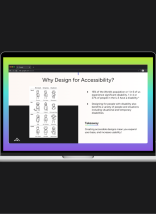Customer experience is everything. It’s that first impression or interaction, that first phone call, that first piece of content we put in front of them. From the work we showcase to our messaging, our customer experience is the most important part of our brand and identity.
As CMO for ABT, facilitating growth and establishing a vision for our marketing strategy are my priorities. What I love about being CMO is how what I do powers the company, and how I can apply my creativity to make it all happen. I am accountable for the entire customer experience, including the moments before they even become a customer. In addition to making this experience exceptional, I also need to make it consistent—from the second they call us, encounter us in a conference, or visit our website, every interaction and every impression matters!
“What I love about being CMO is how what I do powers the company, and how I can apply my creativity to make it all happen.”
How do you do that? Content, content, and more content. But more importantly, you have to produce the right content, in the right channel, at the right moment, in the right way. Sounds super easy, right? In case you didn’t catch that sarcasm, inbound content marketing is actually one of the toughest challenges we CMOs face in our work to build our company brand and generate leads. The following are three key points that I hope you find helpful as you work to fuel your company’s success with lead and demand generation.
1) Align Sales and Marketing
You can generate all the leads in the universe, but they aren’t worth anything if you never close. You cannot be an effective marketer without syncing up with an effective sales team. Sales groups are the ones fielding the calls, so they have a first-hand understanding of your customers’ pain points. An effective marketer listens to the sales team to learn how to reverse engineer the solutions or strategies their customers are aching for.
An easy way to find relevant content topics that matter to your target customers is by meeting with your sales team on a weekly basis. You can use these meetings to plan future content or campaigns based on the latest findings from the sales team. It’s also helpful to get feedback from sales on how your content, events, and other marketing efforts are performing with their leads. If there is any content or messaging the sales team needs to close a lead, the marketing team should be able to deliver it ASAP. This could be as simple as drafting a blog post they can share with the lead, or putting together a slidedeck of related case studies that show off your relevant experience.
It’s also important to train your sales team to provide details about how a lead learned about your company. This gives you valuable insight into the all-important customer experience. Ideally, you want your sales team to answer the following questions:
- How did they hear about us?
- What about this lead’s experience made them decide to reach out?
- What are the lead’s pain points?
- How urgent is their need, and when will they be ready to make a decision?
Once you equip your sales team with the right questions to ask, make sure they capture that data in a central repository like your company’s CRM.
2) Inbound Sales Is the Only Way
Cold calling is dead! Voicemails are the only thing you will hear if you try to target companies and sell to them when they have no idea who you are. The customer of today has become super savvy about screening communications and researching their technical solution options.
With inbound sales facing these challenges, it’s important for the marketing team to arm the sales team with the assets they need to close deals. This means your team has to get creative and devise ways to stand out. One way to do so is by producing content in niche topics that are sought after by your ideal customers. There’s this great book, “They Ask, You Answer” written by Marcus Sheridan, in which he says your goal should be to become the Wikipedia for whatever services you offer. Build that knowledge base for your target market so when they have a need they will educate themselves and find you. Getting the right audience to your site is the hardest part, so let’s talk about how to build your audience and draw them in.
3) Build Your Audience
Because it relies on regular updates, your blog is the most current area of your site and the best opportunity you have for building your audience. You might call it something different than your blog, such as insights, articles, knowledge base, etc. Regardless of what you call it, this section’s purpose is to educate and engage an audience whom you eventually want to convert to a customer.
Because you took my advice and aligned your sales and marketing team, you should have plenty of insight into what topics you should write about in your blog. The idea is that whenever a potential customer sees your company in his or her newsfeed, it’s in connection to a post related to one of their business goals or challenges. For example, if you know your customers will need help updating their websites to meet 508 compliance, make sure you have a blog or two guiding them in how to do that. You give this high-level information away on your site so the reader knows what he or she needs to do, but will want to contact you for help with the design, implementation, or other steps.
Beyond the content of each post, you need to think about threading your blog posts into a unified experience. For example, consider the layout of this post they’ve landed on. Does it provide an easy way to share the post? Do you link to related pages or posts? Would a reader want to subscribe for more? You want to treat each blog as a great opportunity to engage your audience and make it even larger. Below are some quick tips for improving your posts to help build your audience:
- Make it easy to subscribe to your newsletter. A simple CTA will do, but don’t send them away from the page they are on.
- Include easy to find related posts. Publishing a series is a great way to promote other posts within the same subject matter.
- Cross-sell your services and products by linking them within your post.
- Add social share links in as many places as possible, at the beginning and end of the post at minimum. You can also use pull quotes in conjunction with social links to make it easy for them to publish the pull quote.
Treat Marketing as Your Customer Experience
From the moment someone learns about your company, their experience of your brand has begun. By gathering customer insight from your sales team, equipping your team with the right content to reach these customers, and building a rich knowledge base for your ideal audience, you can make your marketing into a powerful experience that draws customers in and wins their loyalty for a long time.








